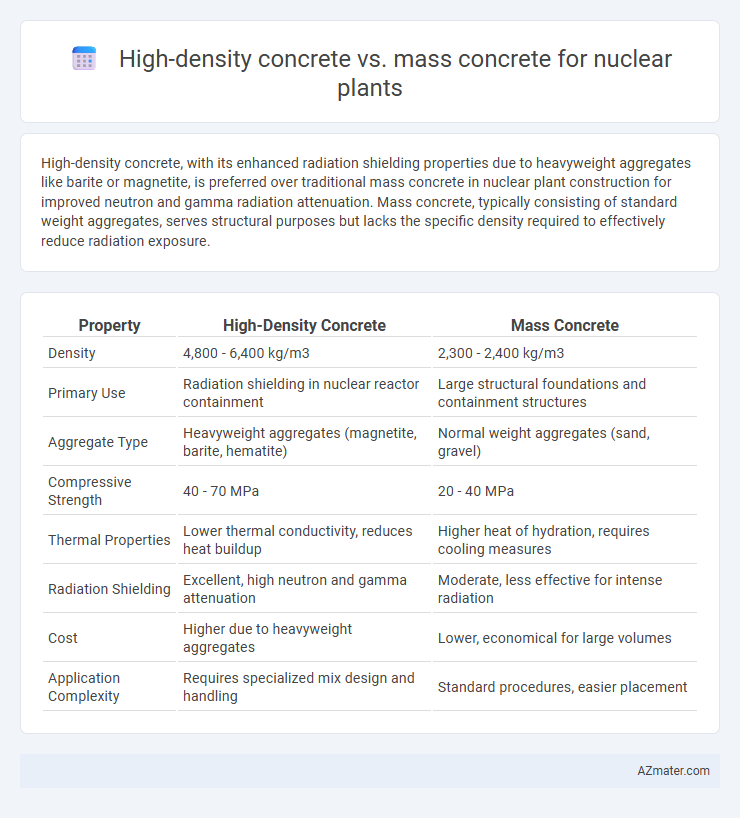High-density concrete, with its enhanced radiation shielding properties due to heavyweight aggregates like barite or magnetite, is preferred over traditional mass concrete in nuclear plant construction for improved neutron and gamma radiation attenuation. Mass concrete, typically consisting of standard weight aggregates, serves structural purposes but lacks the specific density required to effectively reduce radiation exposure.
Table of Comparison
| Property | High-Density Concrete | Mass Concrete |
|---|---|---|
| Density | 4,800 - 6,400 kg/m3 | 2,300 - 2,400 kg/m3 |
| Primary Use | Radiation shielding in nuclear reactor containment | Large structural foundations and containment structures |
| Aggregate Type | Heavyweight aggregates (magnetite, barite, hematite) | Normal weight aggregates (sand, gravel) |
| Compressive Strength | 40 - 70 MPa | 20 - 40 MPa |
| Thermal Properties | Lower thermal conductivity, reduces heat buildup | Higher heat of hydration, requires cooling measures |
| Radiation Shielding | Excellent, high neutron and gamma attenuation | Moderate, less effective for intense radiation |
| Cost | Higher due to heavyweight aggregates | Lower, economical for large volumes |
| Application Complexity | Requires specialized mix design and handling | Standard procedures, easier placement |
Introduction to Concrete Types in Nuclear Plants
High-density concrete, enriched with heavy aggregates like barite or magnetite, provides superior radiation shielding compared to conventional mass concrete used in nuclear plants. Mass concrete, characterized by large volumes and normal-weight aggregates, primarily ensures structural stability and thermal management during curing. Selecting the appropriate concrete type depends on balancing radiation attenuation requirements and structural integrity in nuclear facility construction.
Defining High-Density Concrete
High-density concrete, characterized by a density exceeding 3,800 kg/m3, is specifically engineered for nuclear plants to provide enhanced radiation shielding and structural durability. Unlike conventional mass concrete, which primarily focuses on volume and thermal management, high-density concrete incorporates heavy aggregates such as barite, magnetite, or hematite to achieve superior neutron and gamma-ray attenuation. This specialized composition ensures compliance with stringent nuclear safety standards by minimizing radiation exposure and supporting critical containment structures.
Understanding Mass Concrete
Mass concrete in nuclear plants refers to large volumes of concrete where internal heat generated during cement hydration can cause significant temperature gradients, potentially leading to thermal cracking. Unlike high-density concrete, mainly designed for radiation shielding through high atomic number aggregates like barite or magnetite, mass concrete emphasizes thermal management and structural integrity over shielding properties. Proper understanding of mass concrete's thermal behavior and curing processes is critical to ensuring the durability and safety of nuclear containment structures.
Key Differences: Composition and Properties
High-density concrete for nuclear plants incorporates heavy aggregates such as magnetite or barite, boosting its density to over 3,800 kg/m3, whereas mass concrete typically uses normal aggregates with densities around 2,400 kg/m3. The enhanced density in high-density concrete significantly improves radiation shielding by absorbing gamma rays and neutrons, a critical property absent in conventional mass concrete. Additionally, high-density concrete exhibits lower porosity and higher compressive strength, making it essential for withstanding the extreme environmental conditions within nuclear containment structures.
Radiation Shielding Capabilities
High-density concrete offers superior radiation shielding capabilities compared to mass concrete due to its higher atomic number aggregates such as barites or magnetite, which effectively attenuate gamma radiation and neutron particles in nuclear plant structures. Mass concrete, typically composed of standard aggregates like gravel and sand, provides less dense material, resulting in lower shielding efficiency but still serves structural support purposes. Optimizing concrete density and composition directly enhances radiation protection, critical for ensuring safety and longevity in nuclear power plant containment and shielding walls.
Thermal Management in Nuclear Applications
High-density concrete offers superior thermal management in nuclear plants by providing enhanced radiation shielding and reduced neutron penetration compared to mass concrete. Its dense composition minimizes heat generation and improves temperature stability around reactors, crucial for maintaining structural integrity under high thermal loads. Mass concrete, while cost-effective for large-scale structures, lacks the thermal conductivity and shielding efficiency required for optimal nuclear safety and temperature control.
Structural Performance and Durability
High-density concrete significantly enhances structural performance in nuclear plants by providing superior radiation shielding and increased compressive strength compared to mass concrete. Its dense aggregate composition improves durability against radiation-induced damage and mitigates crack propagation under thermal and mechanical stresses. Mass concrete, while effective for bulk volume, lacks the specialized properties required for optimal long-term structural integrity and radiation protection in nuclear applications.
Construction Methods and Challenges
High-density concrete, used in nuclear plants for enhanced radiation shielding, requires meticulous batching and placement techniques to ensure uniform density and prevent segregation, which poses challenges in achieving consistent strength and durability. Mass concrete, characterized by its large volume and heat generation during curing, demands specialized cooling methods and controlled placement to mitigate thermal cracking and long-term structural integrity issues. Both construction methods face complexities due to precise material specifications, stringent quality control, and the need for advanced formwork systems to accommodate heavy loads and complex geometries.
Cost Comparison and Economic Impact
High-density concrete, enriched with heavy aggregates like barite or magnetite, offers superior radiation shielding but incurs higher material and production costs compared to traditional mass concrete used in nuclear plant construction. While mass concrete provides economical bulk volume and structural stability, the increased density of high-density concrete significantly reduces wall thickness, potentially lowering overall material usage and long-term maintenance expenses. Evaluating life-cycle costs reveals that although initial investment in high-density concrete is greater, its durability and enhanced safety margins can lead to favorable economic impacts in nuclear facility operations.
Recommendation for Nuclear Plant Applications
High-density concrete is recommended for nuclear plant applications due to its superior radiation shielding properties, achieved through the incorporation of heavyweight aggregates like barite or magnetite. It provides enhanced protection against gamma rays and neutron radiation compared to conventional mass concrete, ensuring safety and regulatory compliance. Mass concrete, while cost-effective and structurally robust, lacks the specialized attenuation characteristics crucial for critical radiation containment zones within nuclear facilities.

Infographic: High-density concrete vs Mass concrete for Nuclear plant
 azmater.com
azmater.com